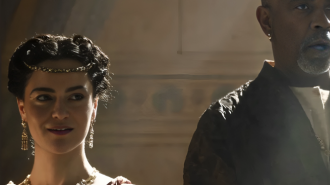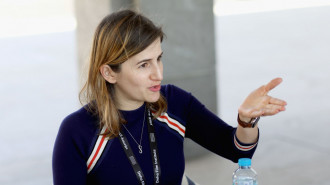
Nefertiti's Bust: The priceless stolen artefact that belongs in Egypt, not Germany

Excavators from all over the world dug in Egyptian soil looking for treasures for their museums when Egypt was under British occupation from 1882 to 1956.
Discovered in 1912, the bust of Queen Nefertiti, wife of 18th-dynasty pharaoh Akhenaten, has been in Germany since it departed Egypt in 1913. Over 3,000 kilometres from its homeland, it is currently displayed at Berlin's Neues Museum.
Egypt's former Minister of Tourism and Antiquities, Zahi Hawass, started a petition on September 7, calling for the return of the sculpture of Nefertiti from Germany.
“Egypt has legal rights to ask and retrieve Nefertiti because it was stolen,” Hawass told The New Arab.
Hawass’ petition urges Egyptians and heritage advocates to sign and calls on Germany’s culture minister, the Prussian Cultural Heritage Foundation, and the Neues Museum to address the petition.
This isn't his first attempt to repatriate the bust.
In 2011, Hawass requested, in the name of the Egyptian government, that Nefertiti's statue be returned to Egypt, and Germany replied, asking for a signed letter from the Minister of Antiquities.
“While I was the Minister at the time, we could not continue negotiations due to the upheaval caused by the January 25 Egyptian revolution,” Hawass revealed.
In January 2011, former Egyptian President Hosni Mubarak appointed Hawass as Minister of State for Antiquities Affairs.
After Mubarak's resignation on February 11, Hawass resigned but was later reappointed by interim Prime Minister, Essam Sharaf. He was later removed in another cabinet shuffle in July 2011.
Hawass noted that many international media outlets covered his latest petition and most signatures were collected from foreigners, not Egyptians.
“Around 7,000 people signed, and our target is one million signatures to pressure Germany into returning the bust,” he told The New Arab.
While Egypt has sought its return many times, arguing that it was taken out illegally, Germany has consistently refused, stating that it was obtained legally at the time.
"The magnificent bust of Nefertiti, one of the finest statues in human history, was taken out of Egypt through deceit, lies, trickery, and illegal means"
A queen found in Tell Amarna
The bust depicts Queen Nefertiti adorned with a gold-decorated, flat-topped blue crown. Its features, including her slender neck, defined jawline, almond-shaped eyes, and full lips, are often regarded as pinnacles of ancient Egyptian art and craftsmanship.
“The magnificent bust of Nefertiti, one of the finest statues in human history, was taken out of Egypt through deceit, lies, trickery, and illegal means,” Bassam El-Shammaa, an Egyptian historian and Egyptologist, told The New Arab.
The bust was uncovered in 1912 at Tell Amarna in the province of El-Minia, by German Egyptologist Ludwig Borchardt, whose excavation mission was funded by James Simon, a wealthy German philanthropist, as noted in a 2023 Cambridge University Press paper by Monica Hanna, an Egyptian Egyptologist.
Under British occupation, Egypt lacked the resources for archaeological exploration and allowed foreign teams to conduct excavations.
The De Jure law of antiquities, governing archaeological excavations in Egypt at the time, dictated how antiquities left Egypt and ensured that uncovered artefacts remained state property to protect the country's cultural heritage, Hanna’s paper revealed.
However, to cover excavation costs, the government allocated some artefacts to the excavators, dividing them into two equal-value lots, but retained the right to repurchase any artefacts it chose at a price not exceeding the excavation costs.
“During the partage process, Borchardt concealed the sculpture’s true value by inaccurately describing it in the division of finds report, fully knowing the regulations of the De Jure Law,” Hanna told The New Arab, supporting El-Shammaa’s claim of illegal acquisition of the bust.
The German historian, Sebastian Conrad, told Deutsche Welle that the sculpture might have been covered with dirt to obscure its colour and beauty.
El-Shammaa similarly said that the bust was found upside down, indicating it fell before being buried and was left dirty to obscure its value during the partage process.
“It can hardly be said that everything was done the right way,” Conrad said.
In February 1913, the bust of Nefertiti was sent to Germany, and later, Simon lent the complete Tell Amarna collection to the Egyptian Museum in Berlin, Hanna revealed.
“In 1920, he donated the Nefertiti statue with the condition that if Egypt ever requested its return, the German National Museums would be legally obligated to repatriate it,” she said.
The Royal Egyptian Legation persuaded the Prussian government, the owner of the statue then after Simon, to repatriate the bust in 1933. However, Adolf Hitler, the chancellor of Germany at the time, refused.
“I will never give up the queen’s head,” Hitler said. “It is a masterpiece, a jewel, a real treasure.”
The beautiful one has come
El-Shammaa, along with many others, admired Nefertiti.
He said, “For a second, I think I fell in love with Nefertiti looking at her picture for too long while writing about her.”
Her name, pronounced Nefert-Iti in hieroglyphics, translates to 'the beautiful one has come,' as 'Nefert' means 'beautiful' and 'Iti' means 'has come,' he said, stating that the statue, sculpted by the ancient Egyptian artist Thutmose around 1340 BC, has great sculpting works.
“Thutmose, originally called ‘Djehutymes’ and pronounced ‘Ju-hoo-ti mes’, was a genius,” he noted, adding that the sculpture's proportions and ratios are unmatched and may have set global standards for sculpting.
“Anyone who wants to learn to sculpt must first study the bust of Nefertiti.”
Hawass agrees with El-Shammaa, calling the Nefertiti bust one of Egypt's finest sculptures.
“Made of limestone and painted with colourful stucco layers, it represents the Amarna Period, a significant era when Egyptians worshipped Aten, the sun deity,” he said.
‘Nefertiti was definitely stolen’
Just like Hawass, Hanna wants Nefertiti to return to Egypt.
She has been a leading voice among the organisers of a petition pressing Egypt's Prime Minister, Moustafa Madbouly, to issue a formal request for its repatriation.
“Our campaign spreads awareness about Nefertiti and stolen Egyptian artefacts through holding lectures, creating posters, and engaging with the media,” Hanna told The New Arab, emphasising that what Egypt needs to reinstitute monumental artefacts is political will, which can only be encouraged through strong public opinion.
She stated that Hawass’ recent petition would not be effective without doing the groundwork of building support and raising awareness to unite and gather the informed masses.
El-Shammaa agreed that the petition is unlikely to succeed but for another reason.
“While it is a positive initiative, 200,000 or a million signatures represent a small fraction of Egypt’s 116 million population,” El-Shammaa told The New Arab, stating that it likely would not sway Germany or the global community to support Egypt.
He stated that for a grassroots campaign like Hawass' to have a substantial impact, it would need to gather substantially more signatures, approximately 50 million.
With 38 years of experience in the field of archaeology, El-Shammaa believes that the only way to bring results would be for Egypt to show its teeth.
“All the diplomatic approaches, gentle strategies, and polite methods have failed,” El-Shammaa said, explaining that if this method does not succeed, Egypt should proceed to the International Court of Justice.
Backing his claim, Hanna argued that Egypt has ethical and legal grounds to request the repatriation of Nefertiti based on the 1912 De Jure law of antiquities and ICOM’s Museums’ Code of Ethics, which prohibits museums from holding looted or illegally obtained objects.
“Queen Nefertiti’s bust was definitely stolen,” Hanna asserted, stressing that Nefertiti belongs in Egypt.
Like Hanna and many other Egyptians who want their heritage returned to their homeland, Hawass told The New Arab, “Nefertiti’s bust is part of our heritage, history, and civilisation; its rightful place is in Egypt, not Germany.”
Nadine Tag is a journalist committed to telling stories about human experiences, reporting real issues, and uncovering the truth







 Follow the Middle East's top stories in English at The New Arab on Google News
Follow the Middle East's top stories in English at The New Arab on Google News


